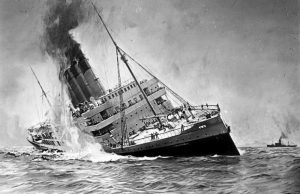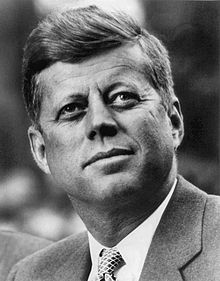
| “I believe that banking institutions are more dangerous to our liberties than standing armies.” |
| Thomas Jefferson |
Find part two of “300 Years of Lies” here.

Follow the money and you’ll uncover the truth. This is the final in a series of four articles, in which I list some of the largest lies over the past three hundred years, and uncover the backgrounds to them.
Banksters and governments together have wound a web of intrigue that is so unbelievable that the general public is slowly coming around to just that conclusion: They are so unbelievable that they are probably true. Indeed, they are.
We’re on the cusp of a major revolution that will uncover many, if not most, of the enormous lies that have allowed the “elite few” to become super-rich and ultra powerful.
The Lies and Warnings (cont’d)
The United States Enters World War I (April 1917)
Lie: The US entered the war when the Lusitania was sunk by the German navy by surprise—with no warning .
 This bit of intrigue begins with Winston Churchill and ends with the then sitting President, Woodrow Wilson.
This bit of intrigue begins with Winston Churchill and ends with the then sitting President, Woodrow Wilson.
In the early stages of WWI, England and France went heavily into debt.
The House of Morgan (as an acting partner of the Rothschilds) had been chosen to handle the sale of bonds in the US. As the war raged on, due to Britain’s deteriorating military position, it was becoming more difficult to raise funds. Morgan also received a commission for the sale of armanents produced by the US (this is where most of the money raised went), so they had more than a little bit of interest in seeing the war persist.
It was obvious on a number of levels that it would be advantageous to have the United States enter the war.
The Lusitania was owned by the Cunard Line (a competitor of JP Morgan, by the way). It was thought of as a luxury liner, but she was really outfitted to be easily converted into a ship of war. She left New York harbor on May 1, 1915 and was sunk by a German U-boat off the coast of England six days later, with 195 Americans on board.
First Lord of the Admiralty, Winston Churchill had instigated a number of policies to help make sure not only that the Lusitania would be sunk, but that the sinking would be instrumental in helping lure the US into the war (it would take a couple of years to complete the process, though).
“The first British countermove, made on my responsibility,… was to deter the Germans from surface attack. The submerged U-boat had to rely increasingly on underwater attack and thus ran the greater risk of mistaking neutral for British ships and of drowning neutral crews and thus embroiling Germany with other Great Powers.”—Winston Churchill
Churchill also ordered British ships to remove their names from their hulls and, when in port, to fly the flag of a neutral power, preferably that of the US. He also provoked the German navy by stating that, “Survivors should be taken prisoner or shot—whichever is the most convenient.”
The Lusitania, after leaving New York, was scheduled to rendezvous off the Irish coast with the Juno, a British destroyer. However, the Juno was called out of the area at the last minute, without informing the captain of the Lusitania. The captain of the luxury liner has also been ordered to cut back on fuel due to costs and so the ship only had 75% of her potential speed.
The Lusitania was carrying a huge cargo of munitions slated for Britain, as well as a passenger list of 1195, 195 of them American. The perfect set-up. It went down in eighteen minutes.
“In March, 1915, the JP Morgan interests, the steel, shipbuilding, and powder interests, and their subsidiary organizations, got together 12 men high up in the newspaper world and employed them to select the most influential newspapers in the United States and sufficient number of them to control generally the policy of the daily press… They found it was only necessary to purchase the control of 25 of the greatest papers… An agreement was reached; the policy of the papers was bought, to be paid for by the month; an editor was furnished for each paper to properly supervise and edit information regarding the questions of preparedness, militarism, financial policies, and other things of national and international nature considered vital to the interest of the purchasers.”—Congressional Record, Feb 9, 1917
And you’re wondering why we’re seeing such one-sidedness of the US media during the presidency of Donald Trump? Most of the US media are owned in part by the Rothschild family.
It was not until two years later that the US entered the war, but the sinking of the Lusitania was a sore point that was latched onto by the media.
In the meantime, well aware of all the goings-on, and having agreed to a secret deal to bring the US into the war, Woodrow Wilson campaigned for his second term based on the slogan, “He kept us out of war.” Behind the scenes, hower, he was pushing Congress for a declaration of war.
In early 1917, it was becoming clear that Britain was in trouble—one out of four steamers leaving the British Isles never returned to port; German submarines were proving highly effective. On April 6, 1917, war was declared on Germany. In the background, financial, political, and military interests had been fulfilled.
The Sudden Death of Louis Thomas McFadden (Oct. 1, 1936)
 Louis McFadden was a Republican member of the United States House of Representatives from Pennsylvania, serving from 1915 to 1935. A banker by trade, he was an opponent of the Federal Reserve System and was the chief sponsor of the 1927 McFadden Act, which limited federal branch banks to the city in which the main branch operates.
Louis McFadden was a Republican member of the United States House of Representatives from Pennsylvania, serving from 1915 to 1935. A banker by trade, he was an opponent of the Federal Reserve System and was the chief sponsor of the 1927 McFadden Act, which limited federal branch banks to the city in which the main branch operates.
In 1933 (during the Great Depression), President Franklin Roosevelt took the US dollar off the gold standard. That’s because foreign powers were trading in their dollars for gold and the Treasury was running dangerously low. The US was in fact, bankrupt.
Americans were forced to turn in their gold and then the dollar was devalued. This move essentially thrust the debt onto the shoulders (and out of the wallets) of the American taxpayer. McFadden was furious. He maintained that the Federal Reserve (being a private bank) was legally obligated to repay the debt to the American people in gold.
In a 1934 address to Congress, McFadden said the following:
“There was no national emergency here when Franklin D Roosevelt took office excepting the bankruptcy of the Fed… Under the cover, the predatory International Bankers have been stealthily transferring the burden of the Fed debts to the people’s Treasury and to the people themselves. They [took] the farms and the homes of the United States to pay for their thievery!… [T]he United States currency is no longer protected by gold. It is therefore sheer dishonesty to say that the people’s gold is needed to protect the currency… I see no reason why the general public should be forced to pay the gambling debts of the international bankers.—Web of Debt, Ellen Hodgson Brown
In 1933, he introduced House Resolution No. 158, which included articles of impeachment for the Secretary of the Treasury, two assistant Secretaries of the Treasury, the Board of Governors of the Federal Reserve, and the officers and directors of its twelve regional banks.
“We have, in this country, one of the most corrupt institutions the world has ever known. I refer to the Federal Reserve Board. This evil institution has impoverished the people of the United States and has practically bankrupted our government. It has done this through the corrupt practices of the moneyed vultures who control it.”—Congressman Louis T. McFadden in 1932
McFadden died rather mysteriously.
During his final month of life, he had two near fatal threats. The first attack involved two revolver shots fired at him as he left a cab. The second attack was another near miss:
“He became violently ill after partaking of food at a political banquet at Washington. His life was only saved from what was subsequently announced as poisoning by the presence of a physician-friend at the banquet, who also procured a stomach pump and subjected the Congressman to emergency treatment.”—Web of Debt, Ellen Hodgson Brown
The final attempt seems to have done it: He was in New York City visiting with his wife and son in late September 1936, when he was taken ill at his hotel and died of coronary thrombosis.
Eisenhower Speech—The Military Industrial Complex (Jan. 17, 1961)
Lie: The military industrial complex (or “Deep State”) is a rather recent concept.
In his farewell speech as he was leaving office, President Dwight D. Eisenhower warned of the Military Industrial Complex and the power they wielded even then.
Eisenhower warns us of the military industrial complex. |
John F. Kennedy Speech—on conspiracies that threaten the United States (April 27, 1961)
Lie: There have been no warnings of a “Deep State” that works outside the wishes of the Oval Office.
This speech was given by President Kennedy at the American Newspaper Publishers Association meeting in New York City. It was only three months after Eisenhower’s warning. You can listen to the entire speech here. An excerpt, highlighting the pertinent passages is below.
“For we are opposed around the world by a monolithic and ruthless conspiracy” that relies primarily on covert means to expand its sphere of influence.”
“On infiltration instead of invasion. On subversion instead of elections. On intimidation instead of free choice. On guerillas by night instead of armies by day.”
“It is a system which has conscripted vast human and material resources, into the building of a tightly knit, highly efficient machine that combines military, diplomatic, intelligent, economic, scientific, and political operations.”
“It’s preparations are concealed, not published. It’s mistakes are buried, not headlined. It’s dissenters are silenced, not praised.”
“No expenditure is questioned. No rumor is printed. No secret is revealed.”
“I am not asking your newspapers to support an administration, but, I am asking your help in the tremendous task of informing and alerting the American people.”
“And there is very grave danger that an announced need for increased security will be seized upon by those anxious to expand it’s meaning to the very limits of censorship and concealment.”
“That I do not intend to permit to the extent that it’s in my control.”
Assassination of John F. Kennedy (November 22, 1963)
Lie: President John F. Kennedy was killed by a lone gunman.
 I don’t imagine there are many people who believe anymore that Lee Harvey Oswald carried out the assassination of President Kennedy on his own. In fact, the consensus now is that he was a patsy and was never even involved in the shooting. There’s been so much written and there are so many videos and films on the internet that I’ll leave to you to do your own research.
I don’t imagine there are many people who believe anymore that Lee Harvey Oswald carried out the assassination of President Kennedy on his own. In fact, the consensus now is that he was a patsy and was never even involved in the shooting. There’s been so much written and there are so many videos and films on the internet that I’ll leave to you to do your own research.
“Although the puppeteers behind Kennedy’s assassination have never been officially exposed, some investigators have concluded that he was another victim of the invisible hand of the international corporate/banking/military cartel. President Eisenhower (above) warned in his 1961 Farewell Address of the encroaching powers of the military industrial complex. To that mix (…) add the oil cartel and the Morgan Rockefeller banking sector, which were closely aligned. Kennedy took a bold stand against them all.”—Web of Debt, Ellen Hodgson Brown
In fact, President Putin of the Russian Federation mentioned the connection in a recent interview.
President Trump has the sole decision on the upcoming scheduled release of all the documents surrounding the assassination in 1963.
| Everything is a Rich Man’s Trick |
| At nearly three and a half hours, Everything is a Rich Man’s Trick examines a defining event of our times from a perspective not often explored. While it may or may not win over viewers who remain skeptical of mass-scale conspiracy, it presents its findings in a measured and meticulous manner which demands attention and consideration. (Warning: This is a 3 hour plus documentary, so allow time) |
They’re trying to censor this video, so if it gets taken off Youtube, you may have to watch it here: https://altcensored.com/watch?v=U1Qt6a-vaNM
The Lies Go On and On
I originally started with a two part article that quickly grew to three and now four parts. I could easily write another two parts.
The final fourth part is yet to come next week. As I do the research, I find more and more stories from the past that just don’t “add up.” When you look at the events of the past several hundred years, knowing the underlying forces at work, it’s much easier to discern what’s real in today’s information explosion and what’s not. Most of it is not.
This third part of the series is heavy in video content, but if you watch it, you may get the feeling that perhaps the “conspiracy theory” that is heavily discounted by major news media is because the major news media are part of the conspiracy.
In the fourth part, we’ll follow the lies right up to today, and take a step back from what’s happening with the Dump Trump conspiracy, which is eventually going to lead to civil war in the United States. Civil wars and countries falling apart are very big themes on the downside of the 516 year cycle.
At the very least, it gives you something to think about. The world is slowly “waking up.”
Part 4 of “Three Hundred Years of Lies” is here.
______________________________
Sources: (links and more information on my recommended books page):
- Web of Debt, Ellen Hodgson Brown
- The Creature from Jekyll Island, G. Edward Griffin
- A History of Central Banking, Stephen Mitford Goodson
- The Public Banking Solution, Ellen Brown
- The Unified Cycle Theory, Stephen J. Puetz
- Climate, The Key to Understanding Business Cycles, Michael Zahorchak
- Tower of Basel, Adam Lebor
- Tragedy and Hope, Carroll Quigley
- Debt, the First 5,000 Years, David Graeber




The most truthful, authentic and complete history of the United State
Thanks. Worked hard on this!